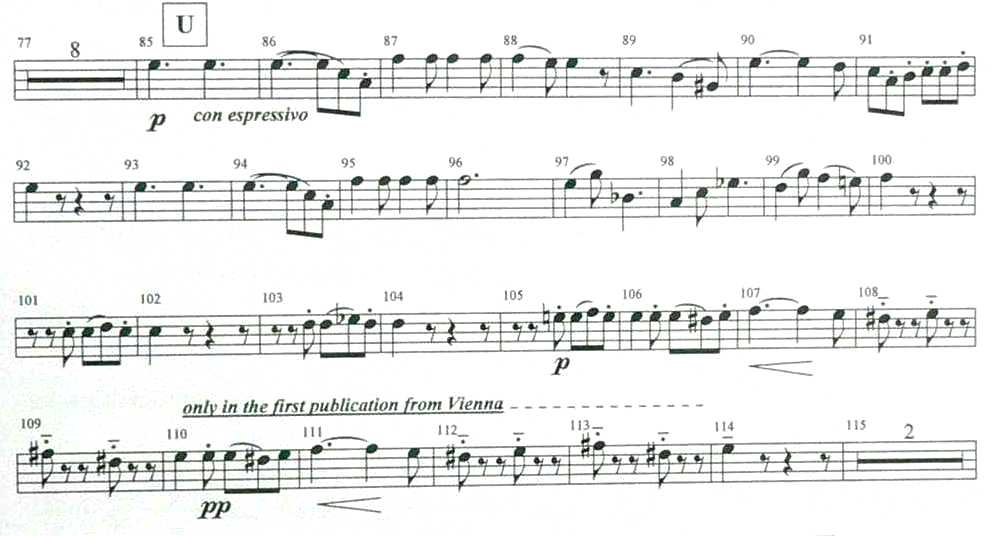|
3eme Concerto pour le Cor op.106 (K.495) |
Ein Waldhorn Konzert für den Leitgeb |
|
How to play this concert |
Interpretationsanleitung |
|
Mozart´s third Concerto for horn, which we named the No.4. Why ? The No.1 D-major is a fragment only, never finished by Mozart himself. |
Mozarts drittes Hornkonzert, das wir als no.4 bezeichnen. Warum ? No.1 in D-Dur ist ja nur ein Fragment, das Mozart nie fertiggestellt hat. |
|
3rd movement: |
RONDO Allegro vivace p.15 |
|
| |
|
The long notes will enter perfect with f2 (T1) followed by the open F-horn e2 (if it is well in tune & not too low, otherwise stay on the Bb-side) & the eb2 (T1), just tumb & 1st valve action.. A nice crescendo, just a little one, would lead to the recapitulation of the initial phrase, but allowing the short echo in M.66. Now comes a new rest of eight measures, a new chance for watering. Just a short comment: As you see I prefer the use of the F-horn, but sometimes recommending the use of the Bb-side on certain spots as a surprise, where most of you might not expect that. But it results in better intonation, more accuracy, easier slurs, fine dynamic. Try it & understand it. |
Beginne die langen Töne mit dem f2 auf T1, gefolgt vom offenen e2 (F0, wenn es nicht zu tief ist, sonst weiter auf dem B-Horn) und dann das es2 (T1), also nur Daumen- & 1.Ventil-Aktion. Ein hübsches leichtes crescendo leitet dann zur Reprise des Eingangsthemas, aber mit kleinem Echo in T.66/67. Während der acht Takte Pause sollte auch schnell "gewassert" werden. Kurze Bemerkung: Wie Du siehst, bevorzuge ich das F-Horn, empfehle aber auch wieder das B-Horn für Stellen, wo Du es nicht erwarten würdest. Aber es ergibt sich daraus bessere Intonation, mehr Sicherheit, leichtere Bindungen und feine dynamische Abstufungen. Probiere es aus, dann verstehst Du es. |
|
| |
|
The entrance at M.84 is nice as F-horn open d2, but it is delicate, as the mood of the movement changes here. Much expression is appropriate. The sequences of quarters & eight notes must remain in tempo absolutely. Back to the entrance M.84: if you change the sound colour somewhat, listeners might think you stay, you hold the notes somewhat longer. A nice expression tool , but you do not hold them longer. But the effect is there and that is very good. Do not forget to get the eb2s all on the T1. In MM. 96 & 98 respectively you can show the nice horn slurs again. d2 = F0, f2 = T1, the ab1 on the F-side, the db2 in the next measure with F2 & the next slur c2-f2 with F0-T1, eb2 (T1) & d2 open F-horn & finally the eb2 again with T1. MM.100-104 are similar to MM.25-27, but with more crescendo. Take care that the single eight notes in MM 107-108 do not rush, but avoid playing them too short. |
Der Einsatz in T.84 ist mit dem offenen d2 auf dem F-Horn besonders schön, aber ganz delikat, da hier der Charakter des Satzes wechselt. Viel Ausdruck ist angebracht. Die Folge von Viertel und Achtel muss absolut im Tempo bleiben. Zurück zum Einsatz in T.84: wenn Du die Klangfarbe etwas veränderst, glauben die Zuhörer, Du würdest stehenbleiben, sozusagen die Töne länger halten. Ein gutes Ausdruckswerkzeug, aber halte die Töne nicht länger. Aber die Wirkung ist da, - und das ist gut so. Vergiss nicht, alle es2 mit T1 zu nehmen. In den Takten 96 & 98 kannst Du wieder hübsche Hornbindungen zeigen: d2 = F0, f2 = T1, das as1 dann auf dem F-Horn, im nächsten Takt das des2 mit F2 und zur nächsten Bindung c2 (F0) - f2 (T1), es2 (T1) und das d2 wieder leer (F) und zum es2 mit T1. T.100-104 entsprechen T.25-27, aber mit mehr crescendo. Laufe nicht bei den einzelnen Achtelnoten in T.107-108, vermeide, sie zu kurz zu spielen. |

